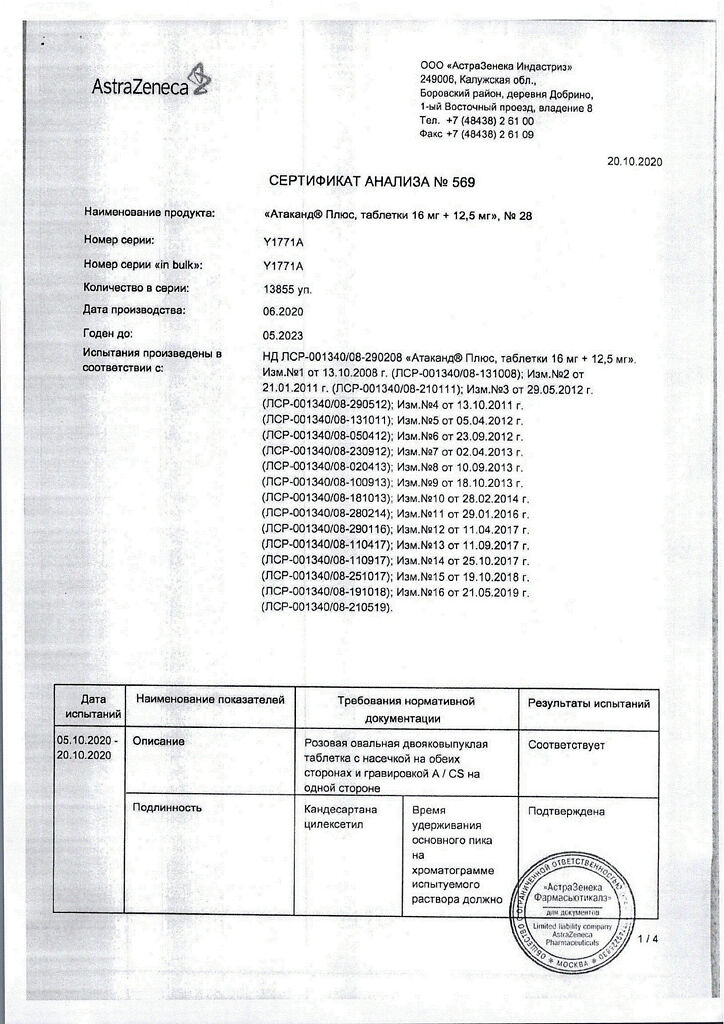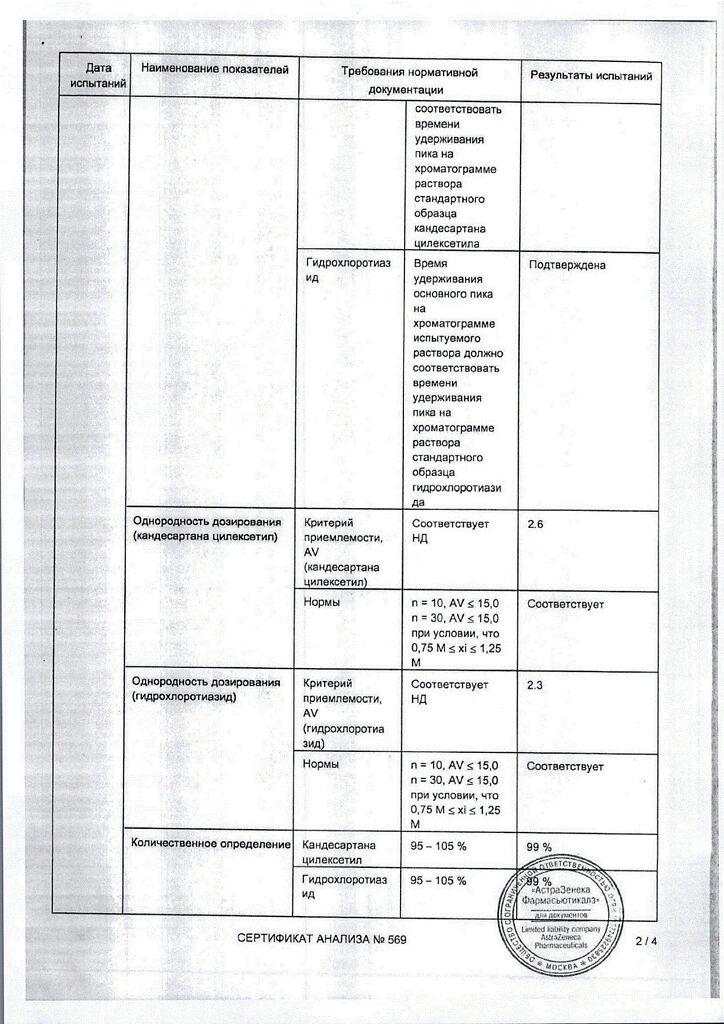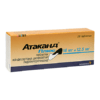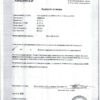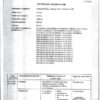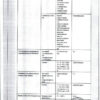Subtotal: €9.06
Atakand Plus, tablets 16 mg+12, 5 mg 28 pcs.
€81.38 €67.81
Atacand Plus is a combined antihypertensive drug. Candesartan selectively blocks AT II receptors (AT subtype,). It prevents the effects of AT II – increase of BP due to vasoconstriction, stimulation of synthesis and release of aldosterone, renin, vasopressin, catecholamines, sodium reabsorption, increase of heart rate.
Creases OPPS, increases renal blood flow and glomerular filtration rate. Causes a compensatory increase in plasma renin activity, AT I and AT II concentrations.
Hydrochlorothiazide causes a moderately pronounced diuretic effect, increasing the excretion of sodium, chloride, potassium and water ions from the body, reducing the volume of plasma.blood and extracellular fluid.
Decreases the content of sodium ions in the vascular wall, reducing its sensitivity to vasoconstrictor effects and thereby increasing the hypotensive effect of candesartan. Atacand plus causes prolonged hypotensive effect without increasing HR.
There is no orthostatic arterial hypotension during the first administration; the AH does not increase after the end of treatment. The hypotensive effect develops gradually and lasts up to 24 hours.
The maximum therapeutic effect is usually achieved 4 weeks after the start of treatment. During absorption in the mucous membrane of the digestive tract it undergoes hydrolysis to form the active substance (candesartan).
Indications
Arterial hypertension.
Pharmacological effect
Atacand Plus is a combined antihypertensive drug. Candesartan selectively blocks AT II receptors (AT subtype). Prevents the development of the effects of AT II – increased blood pressure due to vasoconstriction, stimulation of the synthesis and release of aldosterone, renin, vasopressin, catecholamines, sodium reabsorption, increased heart contractions.
Reduces peripheral vascular resistance, increases renal blood flow and glomerular filtration rate. Causes a compensatory increase in plasma renin activity, AT I and AT II concentrations.
Hydrochlorothiazide causes a moderate diuretic effect, increasing the excretion of sodium, chlorine, potassium and water ions from the body, reducing the volume of plasma, blood and extracellular fluid.
Reduces the content of sodium ions in the vascular wall, reducing its sensitivity to vasoconstrictor effects and thereby enhancing the hypotensive effect of candesartan. Atacand plus causes a prolonged hypotensive effect without increasing heart rate.
Orthostatic arterial hypotension is not observed at the first dose, and after completion of treatment, hypertension does not increase. The hypotensive effect develops gradually and lasts up to 24 hours.
The maximum therapeutic effect is usually achieved 4 weeks after the start of treatment. During absorption in the mucous membrane of the digestive tract, it undergoes hydrolysis with the formation of the active substance (candesartan).
Special instructions
Patients whose vascular tone and renal function are predominantly dependent on the activity of the renin-angiotensin-aldosterone system (for example, patients with severe chronic heart failure, kidney disease, including renal artery stenosis) are especially sensitive to drugs acting on the renin-angiotensin-aldosterone system. The prescription of such drugs is accompanied in these patients by severe arterial hypotension, azotemia, oliguria and, less commonly, acute renal failure. The possibility of developing these effects cannot be excluded when using angiotensin II receptor antagonists. A sharp decrease in blood pressure in patients with ischemic cardiopathy, cerebrovascular diseases of ischemic origin when using any antihypertensive drugs can lead to the development of myocardial infarction or stroke.
The manifestation of hypersensitivity reactions to hydrochlorothiazide is most likely in patients with bronchial asthma, a history of allergic reactions; which does not exclude the occurrence of allergic symptoms in other patients.
When using thiazide-like diuretics, there have been cases of exacerbation or the appearance of symptoms of congestive seborrhea.
The drug contains lactose, so it should not be taken by patients with rare hereditary diseases manifested by lactose intolerance, lactose deficiency or impaired absorption of glucose and lactose.
Use in pediatrics
The safety and effectiveness of Atacanda Plus in children and adolescents under 18 years of age have not been established.
Impact on the ability to drive vehicles and operate machinery
The effect on the ability to drive a car or operate machinery has not been studied, but the pharmacodynamic properties of the drug indicate that there is no such effect. Patients should be careful when driving or operating machinery, as dizziness and increased fatigue may occur during treatment.
Active ingredient
Candesartan, Hydrochlorothiazide
Composition
One tablet contains:
Active substances:
candesartan cilexetil 16 mg,
hydrochlorothiazide 12.5 mg.
Excipients:
carmellose calcium (carmellose calcium salt) 5.6 mg,
hyprolose 4.0 mg,
lactose monohydrate 68 mg,
magnesium stearate 1.3 mg,
corn starch 20 mg,
macrogol 2.6 mg,
iron dye yellow oxide CI 77492 0.21 mg,
iron dye red oxide CI 77491 0.050 mg.
Pregnancy
Atacand Plus is contraindicated during pregnancy;
during lactation (breastfeeding);
in children and adolescents up to 18 years of age (efficacy and safety have not been established).
Contraindications
Hypersensitivity, pregnancy, lactation, primary hyperaldosteronism (resistance to therapy).
With caution. Renal failure, bilateral renal artery stenosis, renal artery stenosis of a single kidney, hyperkalemia, aortic and mitral valve stenosis, HOCM, decreased blood volume, childhood.
Side Effects
Side effects identified during clinical trials were moderate and transient in nature and were comparable in frequency to the placebo group. Discontinuation rates due to side effects were similar between candesartan/hydrochlorothiazide (3.3%) and placebo (2.7%).
In a pooled analysis of the results of clinical trials, the following side effects caused by the administration of candesartan/hydrochlorothiazide were noted. The described side effects were observed with a frequency of at least 1% greater than in the placebo group.
From the central nervous system: dizziness, weakness
Candesartan
The following side effects have been reported very rarely during post-marketing use of the drug:
From the circulatory and lymphatic system: leukopenia, neutropenia and agranulocytosis.
Metabolic disorders and diseases caused by metabolic disorders: hyperkalemia, hyponatremia.
From the side of the central nervous system: dizziness, headache.
From the gastrointestinal tract: nausea.
From the liver and biliary tract: increased activity of liver enzymes, impaired liver function or hepatitis.
From the skin: angioedema, rash, urticaria, itching.
From the musculoskeletal and connective tissues: back pain, arthralgia, myalgia.
From the urinary system: impaired renal function, including renal failure in predisposed patients.
Hydrochlorothiazide
The following side effects have been reported with hydrochlorothiazide monotherapy, usually at a dose of 25 mg or more: common (>1/100), sometimes (>1/1000 and
From the hematopoietic and lymphatic system: rarely – leukopenia, neutropenia/agranulocytosis, thrombocytopenia, aplastic anemia, bone marrow depression, anemia.
From the immune system: rarely – anaphylactic reactions.
Metabolic disorders and diseases caused by metabolic disorders: often – hyperglycemia, hyperuricemia, hyponatremia and hypokalemia.
From the side of the central nervous system: often – mild dizziness, headache; rarely – sleep disturbance, depression, anxiety, paresthesia.
From the side of the organ of vision: rarely – transient blurriness of the image.
From the cardiovascular system: sometimes – orthostatic hypotension; rarely – arrhythmia; necrotizing vasculitis, cutaneous vasculitis.
From the respiratory system: rarely – difficulty breathing (pneumonia and pulmonary edema).
From the digestive tract: sometimes – loss of appetite, diarrhea, constipation; rarely – pancreatitis.
From the liver: rarely – intrahepatic cholestatic jaundice.
From the skin: sometimes – skin rash, urticaria, photosensitivity reactions; rarely – necrosis of the epidermis, reactions similar to cutaneous erythematosis, relapse of cutaneous erythematosis.
From the musculoskeletal and connective tissue side: rarely – myalgia.
From the kidneys and genitourinary system: often – glucosuria; rarely – renal dysfunction and interstitial nephritis.
General disorders: often – weakness; rarely – a feeling of heat.
Laboratory indicators: often – hypercholesterolemia, hypertriglyceridemia; rarely – increased creatinine levels.
Increases in plasma uric acid and ALT and blood glucose were reported as side effects occurring with candesartan cilexetil (estimated incidence of 1.1, 0.9 and 1%, respectively) slightly more frequently than with placebo (0.4, 0 and 0.2%, respectively). In some patients taking candesartan/hydrochlorothiazide, there was a slight decrease in hemoglobin concentration and an increase in AST in the blood plasma.
Increases in creatinine, urea, hyperkalemia and hyponatremia were also observed.
Interaction
Pharmacokinetic studies examined the combined use of Atacanda Plus with hydrochlorothiazide, warfarin, digoxin, oral contraceptives (ethinyl estradiol/levonorgestrel), glibenclamide, nifedipine and enalapril. No clinically significant drug interactions were identified.
Candesartan is metabolized in the liver to a small extent (CYP2C9). Interaction studies have not revealed any effect of the drug on CYP2C9 and CYP3A4; the effect on other isoenzymes of the cytochrome P450 system has not been studied.
The combined use of Atacanda Plus with other antihypertensive drugs potentiates the hypotensive effect. The potassium-wasting effects of hydrochlorothiazide may be potentiated by other drugs that cause potassium wasting and hypokalemia (eg, diuretics, laxatives, amphotericin, carbenoxolone, sodium penicillin G, salicylic acid derivatives).
Experience with other drugs acting on the renin-angiotensin-aldosterone system shows that concomitant therapy with potassium-sparing diuretics, potassium supplements, salt substitutes containing potassium, and other drugs that increase serum potassium levels (for example, heparin) can lead to the development of hyperkalemia.
Diuretic-induced hypokalemia and hypomagnesemia predispose to the possible cardiotoxic effects of digitalis glycoside and antiarrhythmic agents. When taking Atacand® Plus in parallel with such drugs, monitoring the level of potassium in the blood is required.
When lithium drugs are combined with ACE inhibitors, a reversible increase in the concentration of lithium in the blood serum and the development of toxic reactions occur. Similar reactions may occur when using angiotensin II receptor antagonists, and therefore it is recommended to monitor serum lithium levels when using these drugs in combination.
The diuretic, natriuretic and hypotensive effects of hydrochlorothiazide are weakened by NSAIDs.
The absorption of hydrochlorothiazide is weakened by the use of colestipol and cholestyramine.
The effect of non-depolarizing muscle relaxants (for example, tubocurarine) can be enhanced by hydrochlorothiazide.
Thiazide-like diuretics may cause an increase in blood calcium levels due to a decrease in calcium excretion. If it is necessary to use calcium-containing nutritional supplements or vitamin D, the level of calcium in the blood plasma should be monitored and the dose adjusted if necessary.
Thiazide-like diuretics enhance the hyperglycemic effect of beta-blockers and diazoxide.
Anticholinergics (eg, atropine, biperidine) may increase the bioavailability of thiazide-like diuretics due to decreased GI motility.
Thiazide-like diuretics may increase the risk of adverse effects from amantadine.
Thiazide-like diuretics can slow down the removal of cytostatic drugs (such as cyclophosphamide, methotrexate) from the body and enhance their myelosuppressive effect.
The risk of hypokalemia may increase with concomitant use of corticosteroids or ACTH.
While using the drug Atacand® Plus, the incidence of orthostatic arterial hypotension may increase when taking alcohol, barbiturates or general anesthetics.
When treated with thiazide-like diuretics, a decrease in glucose tolerance may occur, and therefore it may be necessary to adjust the dose of hypoglycemic drugs (including insulin).
Hydrochlorothiazide may reduce the effects of vasoconstrictor amines (eg, epinephrine).
Hydrochlorothiazide may increase the risk of acute renal failure, especially when taken with large doses of iodinated excipients.
No significant interaction of hydrochlorothiazide with food was found.
Overdose
Symptoms: analysis of the pharmacological properties of the drug suggests that the main manifestation of an overdose may be a clinically significant decrease in blood pressure and dizziness. Isolated cases of drug overdose (up to 672 mg of candesartan) have been described, resulting in the recovery of patients without serious consequences.
The main manifestation of hydrochlorothiazide overdose is acute loss of fluid and electrolytes. Symptoms such as dizziness, decreased blood pressure, dry mouth, tachycardia, ventricular arrhythmia, loss of consciousness and muscle cramps were also observed.
Treatment: with the development of a clinically significant decrease in blood pressure, it is necessary to carry out symptomatic treatment and monitor the patient’s condition. Place the patient on his back and elevate his legs. If necessary, the blood volume should be increased, for example, by intravenous administration of an isotonic sodium chloride solution. If necessary, sympathomimetic agents can be prescribed. Candesartan and hydrochlorothiazide are unlikely to be eliminated by hemodialysis.
Storage conditions
At a temperature not exceeding 30 °C
Shelf life
3 years
Manufacturer
AstraZeneca AB, Sweden
| Shelf life | 3 years |
|---|---|
| Conditions of storage | At a temperature not exceeding 30 °C |
| Manufacturer | AstraZeneca AB, Sweden |
| Medication form | pills |
| Brand | AstraZeneca AB |
Related products
Buy Atakand Plus, tablets 16 mg+12, 5 mg 28 pcs. with delivery to USA, UK, Europe and over 120 other countries.




